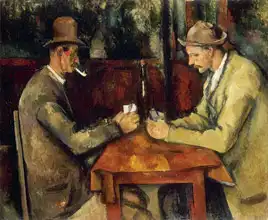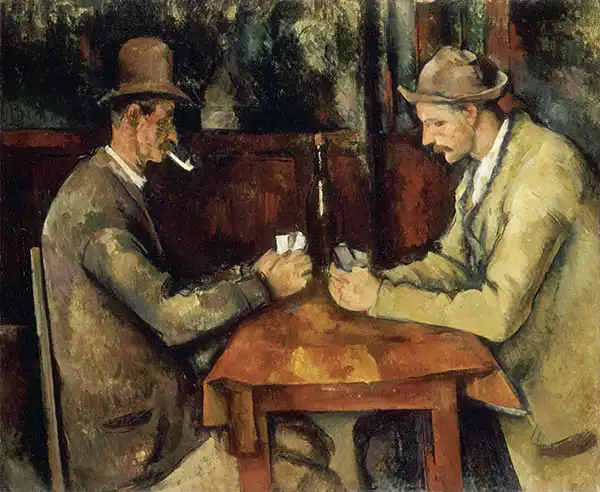About this finishing
Print. The image is printed on the top quality 10-ink HP Z9PS printer on HP matte 270 g / m2 paper. You can choose any size to an accuracy of 1 cm. A margin of 5 cm around the image is added to the size of the motif.


You can find a detailed description about our finishings
here.
Cards players
Date:
1895Medium:
oil on canvasLocation:
Musee d'Orsay, Paris, FranceDimensions:
47.5 x 57"The Card Players" (Les Joueurs de cartes) is a series of oil paintings painted by the French
post-impressionist painter
Paul Cézanne during the 19th century. This series includes several paintings, each depicting a group of men playing cards. The paintings in this series have Cézanne's signature style and emphasize his interest in geometric form and structure.
The color in the paintings of the "Card Players" series is rather muted and limited to an earthy palette, which contributes to the impression of distressing seriousness and simple life. The paintings can also have a certain melancholy and emphasize the simplicity of rural life.
Cézanne was known for his emphasis on structure and composition. The figures are carefully placed within the composition, even though they can feel a bit unnatural due to their heavy and geometric forms.
Cézanne painted picture Cards players in 1895. Prevailing color of this fine art print is brown and its shape is landscape. Original size is 47.5 x 57. This art piece is located in Musee d'Orsay, Paris, France. This image is printed on demand - you can choose material, size and finishing.
Paul Cézanne (1839-1906). French
Post-Impressionist painter whose work laid the foundations for the connection between the concept of 19th century paintings and the more radical 20th century (
especially Kubism). Picasso and Mattise even said that Cézanne is ‘the father of us all’. Cézanne used bright colours and small and delicate brush strokes. Here, you can find most of his later works - mostly studies and still lifes. Cézanne was interested in the simplification of natural forms to their geometric essence. He focused on perspective so that he would provoke a new aesthetic experience in the audience.


